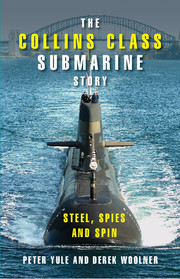Book contents
- Frontmatter
- Contents
- List of key people
- List of acronyms
- Introduction
- Part 1 You Can't Build Submarines in Australia
- Part 2 The Honeymoon Years 1987–92
- Part 3 ‘A Strange Sense of Unease” 1993–98
- 17 End of the honeymoon
- 18 The trials of Collins
- 19 ‘They were problems we didn't expect”
- 20 The role of Defence Science: noise and diesels
- 21 ‘A patch on this and chewing gum on that’: the combat system 1993–97
- Part 4 Resolution
- Notes
- Index
20 - The role of Defence Science: noise and diesels
Published online by Cambridge University Press: 05 September 2013
- Frontmatter
- Contents
- List of key people
- List of acronyms
- Introduction
- Part 1 You Can't Build Submarines in Australia
- Part 2 The Honeymoon Years 1987–92
- Part 3 ‘A Strange Sense of Unease” 1993–98
- 17 End of the honeymoon
- 18 The trials of Collins
- 19 ‘They were problems we didn't expect”
- 20 The role of Defence Science: noise and diesels
- 21 ‘A patch on this and chewing gum on that’: the combat system 1993–97
- Part 4 Resolution
- Notes
- Index
Summary
In the early years of the new submarine project, scientists from DSTO were deeply involved in several key areas, notably steel and welding, the sonars and the development of anechoic tiles. The second phase of DSTO involvement centred on resolving the problems shown up during the trials of the early submarines.
When the results of the noise range testing of HMAS Collins showed that the new submarine was noisier than expected and there appeared to be propeller cavitation, generating more complex noise characteristics, the project team called in the Ship Noise and Vibration Group from DSTO to assess the situation and help the navy argue its case against ASC and Kockums.
This was the beginning of a concerted defence science effort to understand and resolve the problems of the new submarines. Many of DSTO's divisions and experts were to be pulled into the effort but it was the Aeronautical and Maritime Research Laboratories (now Platform Systems Laboratory) in Melbourne under Dr Bill Schofield that was central to research on the submarines, and the Maritime Operations Division in Adelaide that took the scientific lead on the combat system.
- Type
- Chapter
- Information
- The Collins Class Submarine StorySteel, Spies and Spin, pp. 235 - 243Publisher: Cambridge University PressPrint publication year: 2008



